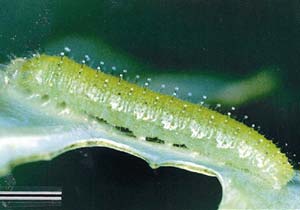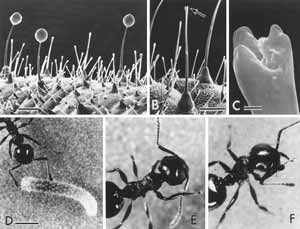Department B/Animal Note
Air Date: Week of May 17, 2002
Living on Earth’s Maggie Villiger reports on a novel survival technique for a caterpillar -- producing its own insecticide.
Transcript
CURWOOD: Just ahead, some folks love them and others hate them. A California town battles over exotic eucalyptus trees. First, this Animal Note from Maggie Villiger.
[THEME MUSIC]
VILLIGER: The European cabbage butterfly is considered a pest here in North America where it likes to feast on vegetables like cauliflower, Brussels sprouts, and of course, cabbage. Scientists wondered what allows this species to gain such a strong foothold wherever it goes. The bug’s secret turns out to be a chemical defense system it produces in its larval stage. Rows of hairs run along the length of these caterpillars’ bodies. The tips of these hairs secrete a clear, oily fluid that collects in drops. In laboratory experiments, researchers watched as ants interacted with the cabbage butterfly caterpillars. As soon as an ant touched the caterpillar’s glistening hairs, it would back off and start frantically cleaning whichever body part had even brushed against the larva.


Caterpillars of the European cabbage butterfly, Peris rapae, (top image) are beset with glandular hairs, bearing droplets of a clear, oily secretion at their tips (image 2A). The tip of each hair is elaborately sculpted (images 2B & C), perhaps allowing the secretion to be held in place as the droplets build up. Ants keep their distance from the caterpillars, and spend a significant amount of time cleansing themselves after making contact with the caterpillar and its offensive secretions (images 2D, E & F).
For good measure, the ant would also clean the body part it had used to clean the initial point of contact. When the scientists isolated the irritating secretion they found a new group of chemicals they named mayolenes. These chemicals derive from a family of compounds that plants use to repel insect attacks. It looks like the European cabbage butterfly is such a successful invader thanks to its own shield of insect repellant. That’s this week’s Animal Note. I’m Maggie Villiger.
[THEME MUSIC OUT]
CURWOOD: And you’re listening to Living on Earth.
[MUSIC: Mellanova, "???," KNOW YOUR ENEMY (Archenemy – 2000)]
Living on Earth wants to hear from you!
Living on Earth
62 Calef Highway, Suite 212
Lee, NH 03861
Telephone: 617-287-4121
E-mail: comments@loe.org
Newsletter [Click here]
Donate to Living on Earth!
Living on Earth is an independent media program and relies entirely on contributions from listeners and institutions supporting public service. Please donate now to preserve an independent environmental voice.
NewsletterLiving on Earth offers a weekly delivery of the show's rundown to your mailbox. Sign up for our newsletter today!
 Sailors For The Sea: Be the change you want to sea.
Sailors For The Sea: Be the change you want to sea.
 The Grantham Foundation for the Protection of the Environment: Committed to protecting and improving the health of the global environment.
The Grantham Foundation for the Protection of the Environment: Committed to protecting and improving the health of the global environment.
 Contribute to Living on Earth and receive, as our gift to you, an archival print of one of Mark Seth Lender's extraordinary wildlife photographs. Follow the link to see Mark's current collection of photographs.
Contribute to Living on Earth and receive, as our gift to you, an archival print of one of Mark Seth Lender's extraordinary wildlife photographs. Follow the link to see Mark's current collection of photographs.
 Buy a signed copy of Mark Seth Lender's book Smeagull the Seagull & support Living on Earth
Buy a signed copy of Mark Seth Lender's book Smeagull the Seagull & support Living on Earth

